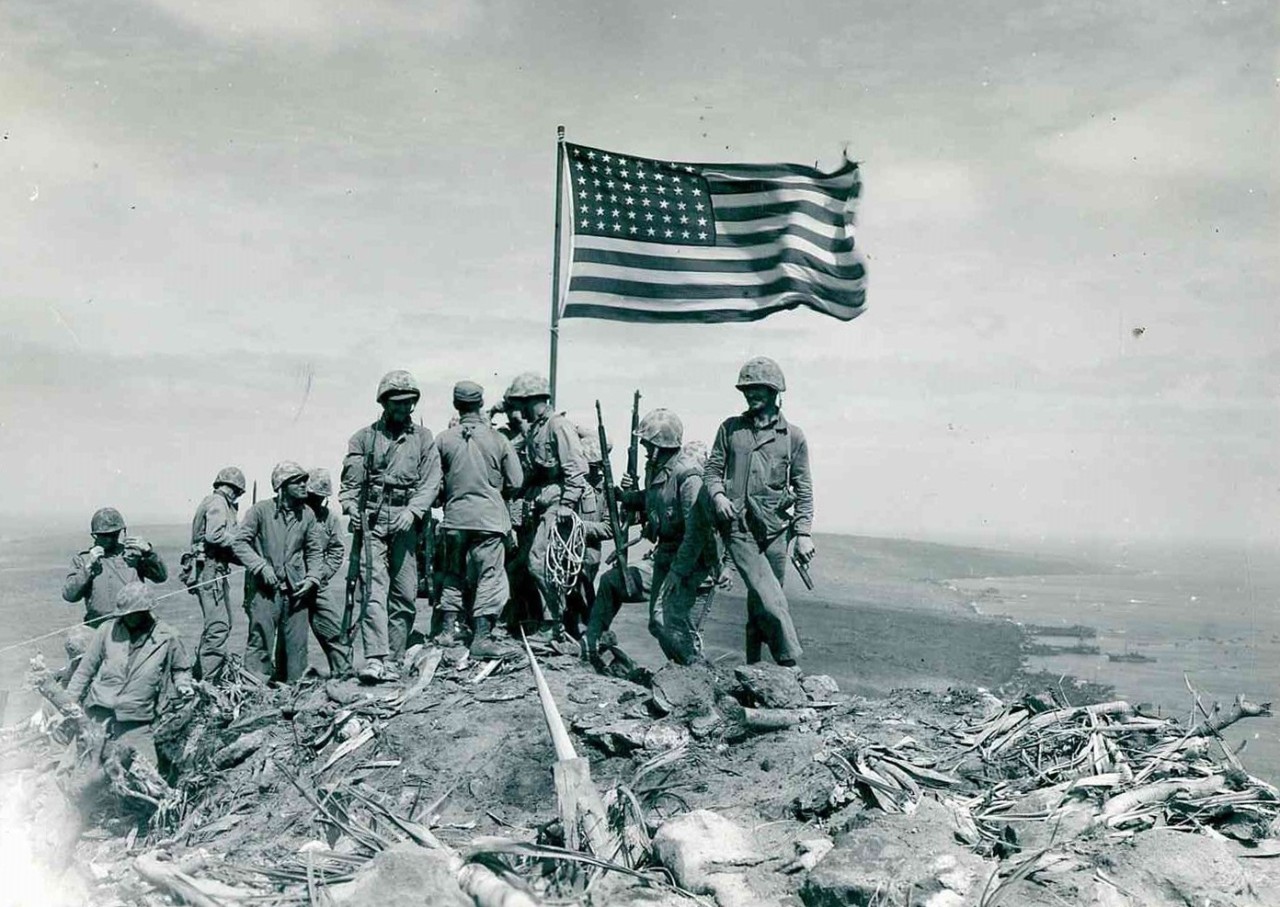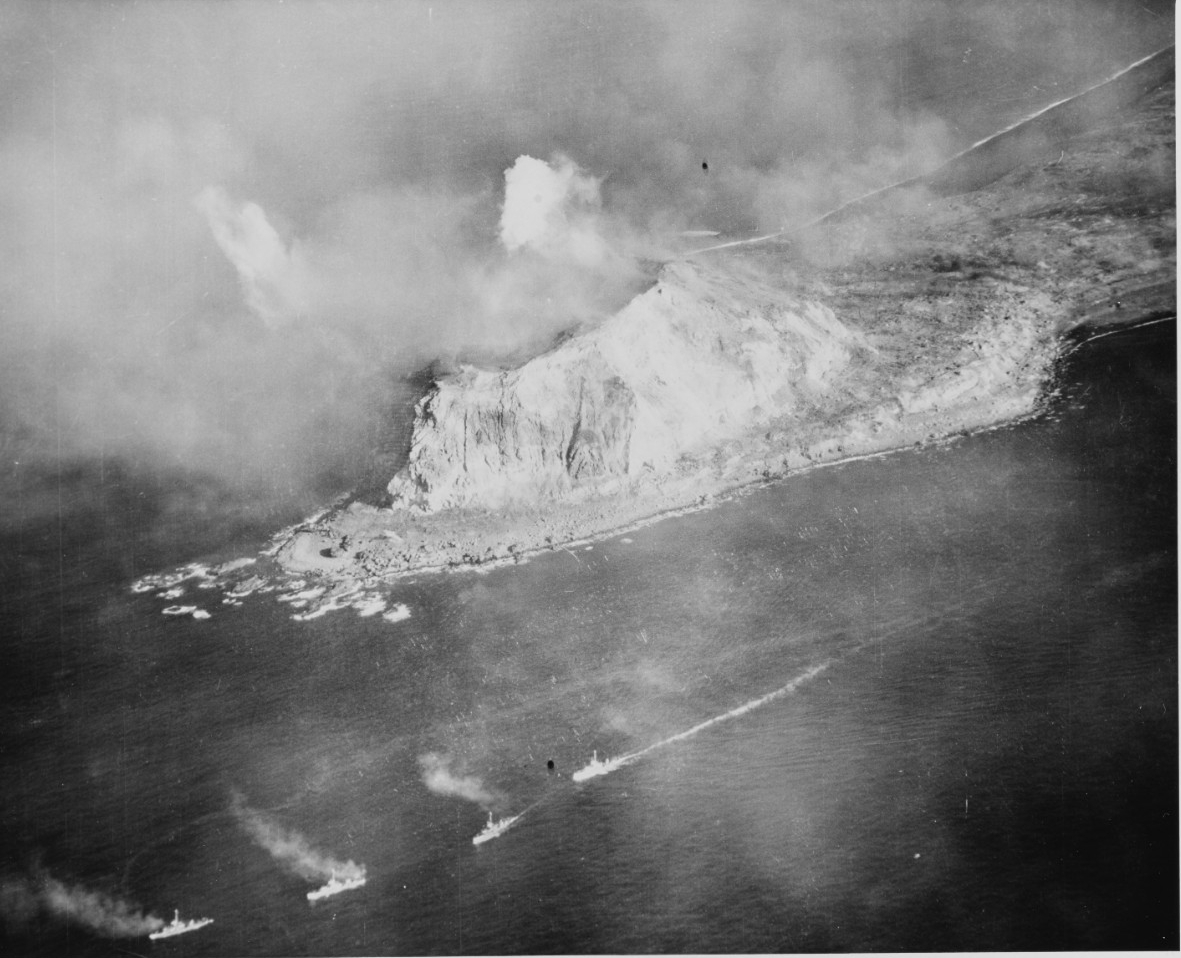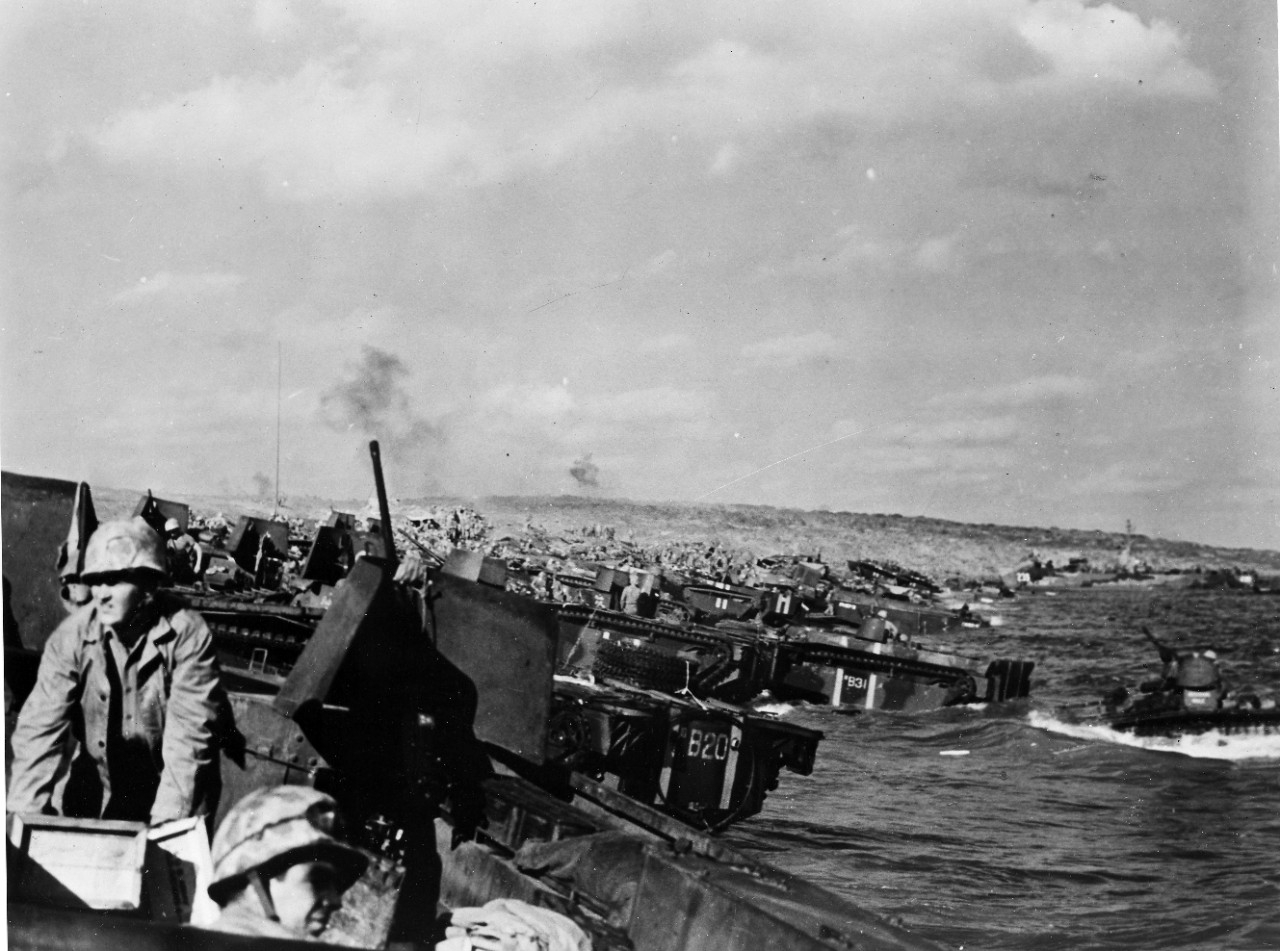Battle of Iwo Jima
19 February–26 March 1945
Background
Operation Detachment, the amphibious assault on Iwo Jima, had its genesis in the 29 September–1 October 1944 strategic planning conference of senior Pacific theater commanders and Joint Chiefs of Staff representatives in San Francisco. Securing Luzon, the largest of the Philippine Islands, received priority following a forceful submission by General Douglas MacArthur, Southwest Pacific Area commander, and his staff. The target date for the Luzon operation was 20 December (although it was actually carried out 9 January 1945, with all strategic locations not secured until March). Luzon was to be followed by the occupation of the Bonins-Volcano group (including Iwo Jima) and of the Ryukus (including Okinawa). Both island chains range roughly north to south in the Pacific south of the central Japanese Home Island of Honchu. Thus, the more easterly Bonins (the Nanpo Shoto) and the more westerly Ryukus (the Nansei Shoto) are figurative stepping stones to the heart of Japan. They were also integral parts of Japan’s vital inner defense zone.
The Bonins operation was to be carried out first, in part due to considerations put forward by the U.S. Army Air Forces, a service branch that had lately come to the fore in the Pacific due to the strategic bombing campaign against Japan. A Japanese radar site on Iwo Jima was assessed as providing early warning to the Home Island air defenses of U.S. air raids as well as a base for intercepting Japanese fighters. B-29 bombing missions consequently had to fly a longer, circuitous route around the island. Moreover, once Iwo Jima was secured, its airfields would be available to fighter aircraft escorting the bombing missions and to battle-damaged or otherwise stricken B-29s for emergency landings. However, in the aftermath of Detachment, it was soon realized that the assumption about Japanese early warning capabilities was not correct and that the airfields’ strategic utility had already been overcome by events elsewhere in the theater. Whether these planning factors justified the operation’s exceedingly high human cost continues to be debated to this day.
Prelude
For Operation Detachment, the U.S. Fifth Fleet (Admiral Raymond A. Spruance) was slated to provide amphibious lift, gunfire support, air cover, and logistical support to the expeditionary task force (TF-56—General Holland M. Smith, USMC). This was primarily made up of V Amphibious Corps (Major General Harry Schmidt, USMC), which comprised the 3rd (reserve afloat), 4th, and 5th Marine Divisions, the Army’s 147th Infantry Regiment, and various support units. D-day was set for 19 February 1945.
The roughly 60,000 U.S. service members taking part in the assault on Iwo Jima were faced by approximately 21,000 Japanese troops. Japanese defensive doctrine had evolved considerably since the Central Pacific battles of 1943 and early 1944. By the Marianas campaign in June 1944, many senior Japanese officers had accepted the impossibility of achieving victory against the Allies and had determined to do their utmost to delay the inevitable at the highest cost they could inflict on their enemy. As Japanese commanders had demonstrated on Peleliu in September 1944, all-out attempts to repulse Allied forces on the landing beaches were no longer undertaken. Instead, the assault troops were to be subjected to a step-by-step battle of attrition, slowly progressing from one well-defended killing zone to the next.
U.S. air superiority—particularly after operations in the Philippines were underway—left Japanese ground forces with negligible or nonexistent air cover against Allied bombing raids. This led to the construction of mutually supporting, deeply sited, and heavily fortified strongpoints, bunkers and artillery positions, often connected by extensive tunnel systems with stockpiles of ammunition and food. The Japanese response to overwhelming American firepower was simple—to dig in and dig deep!
General Tadamichi Kuribayashi, commander of the Japanese forces on Iwo Jima, had been assigned to the island in June 1944 and had immediately begun extensive defensive preparations, with much construction accomplished at night to escape aerial surveillance and attacks. Unlike the Americans, many of whom had viewed the difficult fighting on Peleliu as an isolated aberration rather than as doctrinal evolution, Kuribayashi drew on lessons learned from that battle. Moreover, he discouraged his subordinates from viewing so-called banzai charges as viable tactics, impressing on them that effectively delaying and then killing the enemy were priorities. By the time that Fifth Fleet began bombarding Iwo Jima, all Japanese civilians had been evacuated from the island and Kuribayashi had done everything within his limited means to make the U.S. assault as costly as possible. Iwo Jima’s difficult terrain was to aid the Japanese in this endeavor.
The Battle
Iwo Jima is eight square miles in area and shaped like a pork chop, its widest part oriented toward the northeast. The island’s narrow southwestern tip is dominated by a small mountain, Mount Suribachi, which is a dormant volcano vent. Two completed airfields and one under construction were located respectively from the southwest toward the northeast on Iwo Jima’s centerline. Kuribayashi had divided the island into five defensive sectors with central reserve areas. U.S. planners had designated landing beaches along both southern and northern shorelines between Suribachi and the wider part of the island, but only the southern beaches (from southwest to northeast: Green, Red, Yellow, Blue) were used in the assault.
Bombing raids and occasional naval bombardment had been carried out against Japanese facilities on Iwo Jima since June 1944 and this bombing intensified in the weeks leading up to D-day. Although the air raids damaged some Japanese fortifications, Navy underwater demolition teams landed for a beach reconnaissance overestimated the bombing missions’ impact and did not note the full extent of the Japanese underground fortifications.
V Amphibious Corps requested a concentrated shore bombardment for 10 days prior to the landings. However, citing ammunition supply issues, Task Force 52, the amphibious support force providing fire support, only provided three. Adverse weather curtailed bombardment operations on 16 February, the first day. Ultimately, only 13 hours of effective bombardment were carried out over the three-day period. Fifth Fleet also began minesweeping operations around the island, specifically of the approaches to the designated landing beaches. Prior to the operation, Spruance had detached Task Force 58, his fast carriers (which also carried eight Marine Corps fighter squadrons), to strike strategic targets on Honshu in wide-ranging support of the Iwo Jima landings. The Marines, already unhappy with the shortened duration of naval gunfire support and believing continuous close air support of the ground forces should take priority, hardly welcomed this decision.
Almost precisely at H-hour, 0900 on 19 February, the first assault wave, with 5th Marine Division units on the left and 4th Marine Division units to the right, landed on the assigned beach sectors. The Japanese held their fore until 1000, after the Marines’ first wave was on the beaches and the covering naval gunfire had momentarily eased. The sudden, unexpected volume and accuracy of artillery and mortars clearly indicated that bombing and naval bombardment had not markedly affected the enemy. This had a devastating effect on the buildup on the beaches. All of the sectors suffered casualties, although Green and Red beaches, flanked by Japanese positions on Mount Suribachi, and the Blue beaches, fronted by enemy emplaced in the cliffs of a rock quarry, were perhaps hardest hit. Further handicapping the Marines was the instable beach, composed of steep terraces of constantly shifting black sand, volcanic cinders, and ash. This made digging in very difficult and bogged down wheeled and even tracked vehicles, causing pile-ups of men, amphibious tractors, tanks, and supplies at the waterline. These were subjected to constant Japanese artillery, mortar, and machine-gun fire. The steep beach gradient also caused a violent surf zone with which landing craft and tractors had to contend.
These difficulties notwithstanding, the landings were successfully executed and, under cover of a rolling naval gunfire barrage and close air support mainly provided by Fifth Fleet’s escort carriers, the Marines began moving off the beaches. The 5th Marine Division pushed to the northwestern shore in order to isolate Mount Suribachi, and accomplished this task within ninety minutes of the initial landings. The 4th Marine Division’s progress was much slower, however, as it proceeded toward the airfields. One of these lay directly in front of the Marines, but the second, more centrally located field, required a wheeling movement toward the northeast, which brought most of this division into a bowl-like area completely exposed to heavy Japanese fire.
By the end of D-day, nearly 30,000 personnel had been landed on Iwo Jima despite rapidly deteriorating weather conditions, the difficult terrain, and stubborn, well-coordinated Japanese resistance. Although the Marines had managed to cross the island at its narrow width and had cut off Mount Suribachi, the day’s planned phase line had not been reached while casualties mounted at an alarming rate. The beachhead remained concentrated in a triangular area roughly 4,000 yards long, and from 700 to 1,100 yards wide from north to south.
D+1 saw the landing of 3rd Marine Division, the corps reserve, and later taking up battle space between the two previously committed Marine divisions. Meanwhile, the 5th Division’s 28th Marine Regiment began its assault of Mount Suribachi, which was garrisoned by 2,000 Japanese troops and extensively honeycombed with defensive positions and tunnels, one of them seven levels deep. Bolstered by reinforcements from 3rd Marine Division, other 5th Marine Division units and the 4th Marine Division slowly continued to force their way northwest and northeast. Navy destroyers, many assigned to specific Marine units, provided direct gunfire support. Although frequently the targets of Japanese guns, Marine tanks, amphtracs and artillery did the same, providing mobile firepower to the engaged infantry units. Fifth Fleet aircraft continued to fly close-support missions, often dropping napalm on the deeply dug-in enemy.
Ultimately, however, small teams of Marines—or even individuals—armed with flame throwers, satchel charges and hand grenades (“blow torches and corkscrews”) were those who were instrumental in destroying Japanese strongpoints. The cost was commensurate: By the end of D+1, many Marine rifle companies had lost up to 50 percent of their pre-assault strength in killed and wounded. Operational momentum remained extremely slow and progress was measured in yards of ground taken.
From 21 February (D+2) into March, despite Japanese tenacity and ingenuity, U.S. forces were gradually able to make significant advances. During the night of 21–22 February, ships on the outer periphery of the amphibious landing area were subjected to the only kamikaze attack experienced during the operation. The escort carrier Bismarck Sea (CVE-95) was lost and fleet carrier Saratoga (CV-3) was so badly damaged that she had to return Stateside for repair and never returned to combat. Ashore, while the Marines reached the summit of Mount Suribachi on the morning of 23 February soon after the initial landing, the rest of the battle for the island would take the month that followed in heavy fighting. Despite the iconic and certainly morale-boosting flag raising, hidden pockets of enemy continued their resistance on the mountain—a blow to Kuribayashi’s defences. Airfield No. 1, the southernmost air facility, was captured after hard fighting by D+1 while the Marines continued to move northward, aided by an armored task force of several Marine tank companies.
As they advanced, they encountered well-coordinated and -led counterattacks by the Japanese—a surprise to those U.S. service members who had experienced chaotic enemy banzai charges in the past. Tanks were put out of action by mines, suicide squads or well-camouflaged antitank guns, and the Marine rifle companies were subjected to constant artillery, mortar, and small-arms fire. To the frustration of the ground forces, many Japanese positions proved impervious to close air support bombing and strafing and had to be taken by direct ground assault or by sealing off entrances. After nine days, the drive north had progressed 4,000 yards at a cost of 7,000 U.S. casualties but by 4 March, Airfield No. 2 had been secured after hard fighting and the Marines had degraded General Kuribyashi’s defenses to the point at which many Japanese heavy weapons were out of action. Also on 4 March, the 9th Bomb Group B-29 “Dinah” made an emergency landing on Airfield No. 1. It refueled and departed, demonstrating the potential use of the island by XXI Bomber Command. On 14 March, the island’s occupation was officially announced, although fighting continued for two further weeks. Finally, on 26 March Iwo Jima was declared “secure.”
Aftermath
Of the roughly 21,000 Japanese defenders, 216 survived the battle to be taken prisoner, and an estimated 3,000 went into hiding during the U.S. occupation of the island. By August 1945, Most of these had either been killed, captured, or had surrendered, but one group did not lay down its arms until 1949. Having done his utmost to forestall the inevitable, General Kuribayashi committed suicide in his command post on 23 March 1945.
The perceived strategic position and utility of the island were not immediately apparent to its occupiers. The Japanese radar station, the American operators soon learned, had actually been incapable of providing necessary early warning data to Japanese Home Island air defenses. For their part, prior to Operation Detachment, the Japanese had effectively written off the island’s airfield for any significant operational employment. As a way station for U.S. Army Air Forces aircraft, Iwo Jima again appeared to offer little advantage. Utilizing Iwo Jima’s airfields for U.S. escort fighters in the end proved to be logistically difficult and very hard on the P-51 pilots, who faced a 1,500–nautical mile round trip. The fields’ capacity, moreover, was limited—about the same as that provided by one Navy fleet carrier. Far fewer B-29s than anticipated actually made use of the island as an emergency landing or refueling site. The airfields did host an active search-and-rescue operation, but the number of downed U.S. aviators picked up by aircraft from Iwo Jima (57) seems insignificant in comparison to the number of lives lost in the island’s capture.
Operation Detachment cost U.S. forces 6,871 killed and 19,217 wounded. Medals of Honor were awarded to 22 Marines and five Sailors, 14 of them posthumously (13 Marines, one Sailor). As Admiral Chester W. Nimitz, commander of Pacific Fleet and Pacific Ocean Areas, noted after the battle, “uncommon valor was a common virtue.”
—Carsten Fries, NHHC Communication and Outreach Division, February 2020
Suggested Reading
Account of the Battle of Iwo Jima
Oral History—Iwo Jima Flag Raising by Pharmacist's Mate Second Class John H. Bradley, USN
Battle of Iwo Jima: A Select Bibliography
Amphibious Operations: Capture of Iwo Jima
Account of the Battle of Iwo Jima by Saxon Palmeter
Morison, Samuel Eliot. History of United States Navy Operations in World War II, Vol. XIV: Victory in the Pacific, 1945. Little, Brown and Co., Boston, 1960.
Video: United States Marine Corps War Memorial
This video depicts actual war footage from the Battle of Iwo Jima and, at times, has graphic representations of the reality of war and the ultimate sacrifice. Iwo Jima provides a crucial lesson about the demands of warfighting with a near-peer competitor in the far Pacific. The sacrifice and valor of those before us have forged a stronger, more formidable Navy and Marine Corps team.
Infographics
Brave, Bold, and Fearless Firsts: The Wartime Experiences of Two Women at Iwo Jima and Okinawa. An infographic on Barbara Miller Finch and U.S. Navy flight nurse Ensign Jane "Candy" Kendeigh.
NHHC Artifacts
Battle of Iwo Jima Artifacts. Collection includes Lieutenant John Crotty's chaplain's stole, USS Shasta (AE-6) ensign flown during the battle, and cold-weather gear used aboard USS Leedstown (APA-56) during the Iwo Jima operation.





